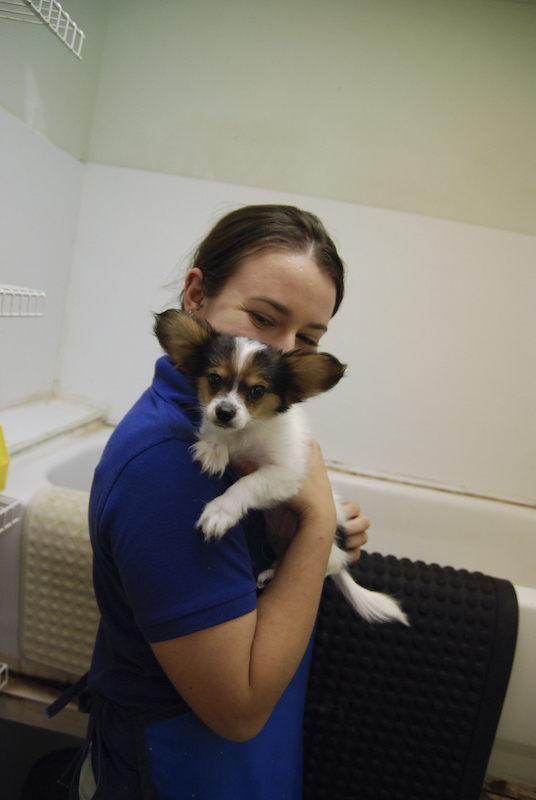Prevent a Lifetime of Suffering: Screening and Treatment of Puppies for Hip Laxity and Hip Dysplasia

What is Hip Dysplasia?
Hip dysplasia is the abnormal development of the hip joint characterized by excessive hip laxity that leads to osteoarthritis. It is the most commonly inherited orthopedic disease in dogs. Hip dysplasia is one of the most common diseases of large breed dogs, but can occur in smaller breeds too.
Hip dysplasia is painful in young dogs because abnormal wear of joint cartilage exposes pain fibers in underlying bone and laxity causes stretching of surrounding soft tissues. In older dogs, hip dysplasia causes pain through osteoarthritis. In severe cases, arthritic changes and crippling pain can be seen in dogs as young as one year of age.
The hip joint is a ball-and-socket joint, with the ball of the femur (femoral head) fitting into the hip socket (acetabulum). Hip laxity refers to the degree of “looseness” of the ball in the hip socket. Studies have shown that dogs with looser hips (excessive hip laxity) are at higher risk to develop hip dysplasia than dogs with tighter hips (minimal hip laxity).
How can my dog be screened for Hip Dysplasia?
The research-based hip-screening x-ray procedure known as PennHIP (University of Pennsylvania Hip Improvement Program) has proven to be the most accurate and precise method to measure hip laxity. It can identify—as early as 13 weeks—dogs that are susceptible to developing hip dysplasia. We recommend screening all dogs within hip dysplasia prone breeds for hip laxity at 13-14 weeks of age.
Breeds for which PennHIP Screening is Recommended
The PennHIP procedure requires specialized training and certification. Three of our veterinarians, Drs. Welborn, Armstrong, Clarke, and Callahan are the only veterinarians in Hillsborough County to have received PennHIP certification. They are available to perform the procedure at our locations that have state-of-the-art digital x-ray systems, North Bay Animal Hospital, Temple Terrace Animal Hospital and Pebble Creek Animal Hospital. The total cost of the PennHIP procedure including sedation, x-rays and evaluation by PennHIP is $375-400.
What are the options for treating Hip Dysplasia?
Traditional surgical techniques used to treat hip dysplasia such as triple pelvic osteotomy (TPO), femoral head ostectomy (FHO), and total hip replacement (THR) surgeries are invasive, can be associated with significant pain, have a long recovery time, and are expensive, as some of these procedures can exceed $4,000.
Juvenile Pubic (Pelvic) Symphysiodesis (JPS) is a relatively new minimally invasive procedure for the treatment of hip dysplasia. This procedure is done in young dogs that screen positive for hip laxity. The JPS procedure has proved to be, in both experimental and clinical studies, performed primarily at the University of Wisconsin School of Veterinary Medicine, a surgical procedure that can reduce the development of hip dysplasia and therefore reduce secondary osteoarthritis.
During JPS surgery, electocautery is applied to the growth plate of the pubis (part of the pelvic bone) resulting in closure of the growth plate. During the dog’s normal growth after surgery, the other growth plates within the pelvis fuse naturally, at 20-24 weeks of age depending on the breed, which causes changes to the angles of the pelvis and hips. These changes result in a tighter fit of the ball-and-socket hip joint and a decrease in the abnormal wear and tear and premature osteoarthritis associated with hip dysplasia.
JPS surgery is short in duration and, unlike other surgical procedures for hip dysplasia, requires no cutting of bone or orthopedic implants. Typically dogs spend only one night in the hospital and experience minimum discomfort. In addition, the cost for this surgery is considerably less expensive compared to traditional procedures for hip dysplasia. In order to be effective, it must be performed before 20-24 weeks of age depending on the breed. JPS surgery provides greatest benefit if it is performed several weeks prior to the time of natural pelvic growth plate closure.
For more information about PennHIP or Juvenile Pubic Symphysiodesis, please feel free to contact:
Link V. Welborn, DVM, DABVP, CCRT
Board Certified in Canine and Feline Practice
Cell: 813-695-0148
Fax: 813-464-7648
- Behavior (11)
- Caring for your pet (263)
- cat (4)
- Community Events (19)
- dog (6)
- From Our Clients (15)
- Happy Tails (8)
- News (418)
- Press (53)
- Products (2)
- Questions (4)
- Recalls (1)
- Special Offers (5)
- Tips & Advice (231)
- Uncategorized (19)
- Veterinary Services (48)
